There are 6 different types of skinks in Alabama. The state has some of the most diverse reptiles and amphibians in the US.
The skinks in Alabama are widely distributed throughout the state, some species more than others. You can often find most skinks in moist habitats with loose soil. However, some prefer drier habitats.
This article will discuss all the different skink species you can find in Alabama. So whether you are here on a school assignment, are considering getting a skink pet, or plan to go herping in the state, you are bound to learn something valuable.
Many skinks are secretive. As a result, they tend to stay away from open places, ranging only within their natural habitats. Others are comfortable in open spaces, and you can find many in residential areas.
Regardless of the species, all skinks are wary of predators and typically run from them. However, if grasped, these lizards may try to break free by breaking off their tail to distract the predator. This process is called autotomy.
Want to dive deeper into this fascinating topic? Read on to learn about the different types of skinks in Alabama.
Table of Contents
Skinks in Alabama
1. Coal Skink
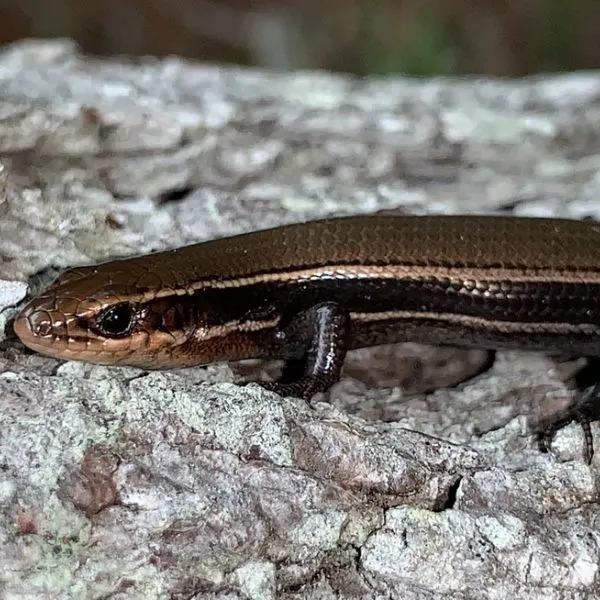
- Experience Level: Advanced
- Family: Scincidae
- Scientific Name: Plestiodon anthracinus
- Other Names: Black Skink
- Adult Size: 5 to 7 inches
- Lifespan: 6+ years
- Average Price Range: N/A
Young coal skinks look like they were dipped in black grease. Hatchlings are pitch-black, with skins that seem to glimmer in the sun. While most are born without light lines, some have faint lines at birth.
These lizards are born with stunning bright blue tails and white or reddish markings on their heads. However, this pattern changes as the lizards mature. The blue tail coloration fades, their black skins fade to brown, and they develop four lateral light lines, two on each side.
Mature coal skinks are four-lined skinks with one broad dark stripe between each pair of light lines. These broad stripes extend from the snout down the lizards’ bodies. During breeding seasons, males develop orange tints around their jaws.
You can find coal skinks in humid habitats close to streams or ponds. As a result, they tend to live in coastal plains or wet forest areas abundant with floor debris.
Coal skink sightings are uncommon because these lizards are extremely shy. Therefore, it may take considerable time to encounter one even if you visit areas where these skinks live in Alabama.
The secretive, evasive behavior of coal skinks has puzzled biologists for a long time. It also contributes to the scarcity of information on their natural history because they are challenging to observe in the wild.
Coal skinks rarely bask out in the open. Instead, they spend most of their time foraging under the debris or leaves in their habitats. Those that bask openly often restrict themselves to the surrounding of their shelter.
If you happen upon these skinks on the few occasions they bask openly, they are likely to take shelter immediately. This often involves scurrying under leaves or rocks, but some may dive into streams.
Coal skinks eat high-arthropod diets, consisting of insects, arachnids, and crustaceans.
2. Northern Mole Skink
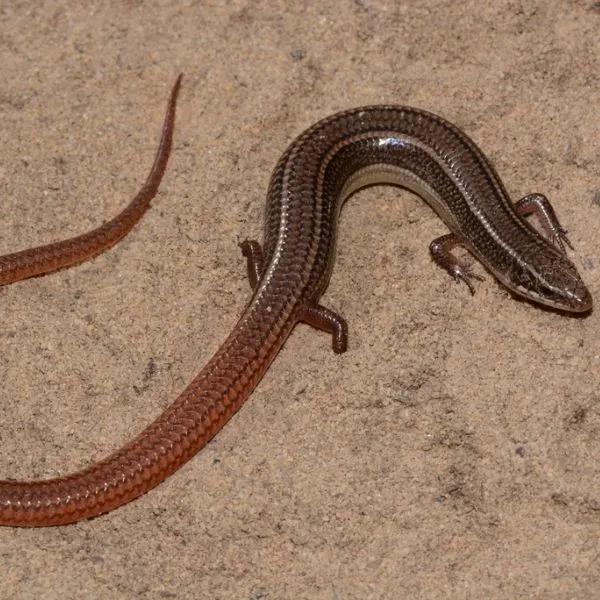
- Experience Level: Advanced
- Family: Scincidae
- Scientific Name: Plestiodon egregius ssp. similis
- Other Names: Mole Skink
- Adult Size: 3.5 to 6 inches
- Lifespan: N/A
- Average Price Range: N/A
There are five different subspecies of mole skinks, but all are native to Florida. Only northern mole skinks occur outside the sunshine state, and there are only a few of these skinks in Alabama.
Many skinks are often mistaken for snakes when glimpsed from a distance because of their appearance. Still, the northern mole skink is the likeliest to be mistaken for a snake in Alabama.
It has much smaller, spaced-out limbs and a tail longer than its body. These tiny limbs give it a more streamlined appearance and make locomotion in loose sand easier. Also, it is a predominantly burrowing lizard, so it only uses its limbs for surface movement.
Like many skinks in Alabama, the northern mole skink has a stunning blue tail when young. But it has no stripes. Unlike coal skinks, juveniles of this species are not jet-black.
Adults have gray to brown skins and lose their juvenile blue tail coloration. You can identify them by their characteristically reddish tails. No other skink in the state displays this tail coloration.
Northern mole skinks are few in Alabama, so little is known about them. While uncommon, you are more likely to encounter them in dry sandhills and rocky areas. Also, these lizards are not true sand swimmers, even though they love to swim in loose soil.
You can feed these small reptiles with insects of various kinds, from crickets to cockroaches. They also eat other arthropods and small invertebrates, including worms.
3. Common Five-lined Skink
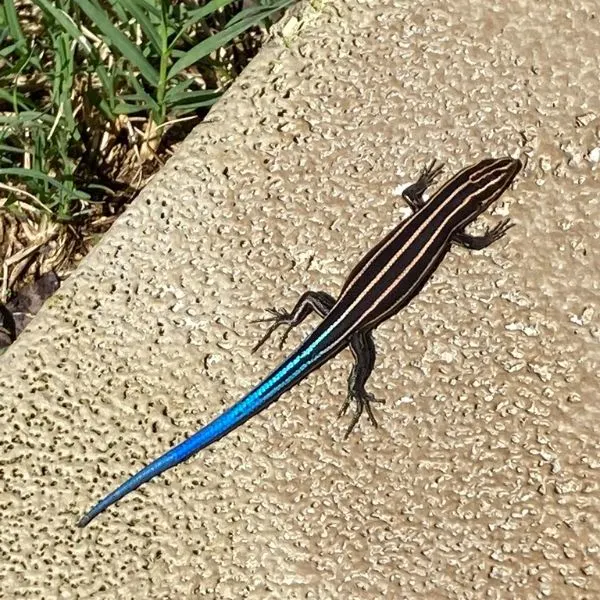
- Experience Level: Intermediate
- Family: Scincidae
- Scientific Name: Plestiodon fasciatus
- Other Names: American Five-lined Skink, Five-lined Skink
- Adult Size: 5 to 8.5 inches
- Lifespan: 6 to 10 years
- Average Price Range: N/A
Five-lined skinks are arguably the most common skinks in North America. Many live in Alabama, and they have the widest skink distribution in the state.
These lizards display a dramatic pattern change between childhood and adulthood. Juveniles have black ground colors with five thin dorsolateral light stripes and a blue to purple tail.
In adulthood, this tail coloration disappears, and the ground color lightens to brown. Adult females are darker and retain darker shades of their juvenile stripes.
On the other hand, adult males are lighter with less apparent stripes. Older male adults may lose all traces of these stripes and develop uniformly brown skins.
Five-lined skinks are territorial. Therefore, you are likely to see adult males fighting each other for territory or mating rights. Reproductively males also develop orange jaws that are brightest during breeding seasons.
You can find five-lined skinks in various habitats across Alabama. However, these skinks are most at home in forests with plenty of moisture, leaf litter, and rotting logs.
Five-lined skinks enjoy staying on the ground as much as they love climbing. So you may find them perched on tree branches basking in the sun or searching for food. You are also likely to find them in gardens or basking on walls in residential areas.
If you decide to keep this species in your terrarium, make its enclosure optimal. Ensure the place has good vegetation, moisture, and basking spots. Also, install UV lighting it can bask in.
While five-lined skinks are easy to care for, they are not cuddly pets. They dislike handling and are more fun to watch without contact. If you are comfortable with this, this species is perfect for you.
You can feed your five-lined skink with arthropods, worms, and small servings of fruits and vegetables.
4. Broad-headed Skink
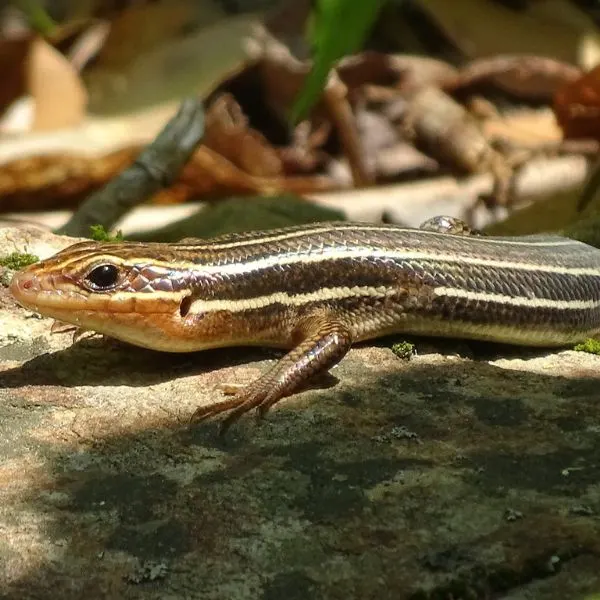
- Experience Level: Advanced
- Family: Scincidae
- Scientific Name: Plestiodon laticeps
- Other Names: Broadhead Scorpion, Five-lined Skink
- Adult Size: 6 to 13 inches
- Lifespan: 6 to 10 years
- Average Price Range: N/A
Broad headed skinks are the largest skinks in Alabama. They get their name from the distinctly broad, triangular heads of male adults. This feature makes it hard to mistake mature males for other skinks in the state.
Like the common five-lined skink, broadheads have five thin light stripes. These lines are often absent in male adults but are pronounced in juveniles and adult females. As a result, people often mistake mature females and juveniles for other five-lined species.
Young broadhead skinks have black skin and bright blue tails. The blue tail fades as the lizards mature, while the brown skin lightens to brown. Adult females often become dark brown, while males are light brown to bronze with orange heads.
If you encounter broadhead skinks in the wild but are unsure if they are broadheads or common five-lined skinks, check the scales. A broadhead skink might lack postlabial scales, but they have five supralabial scales in front of at least one eye.
Broadhead skinks are the most arboreal skinks in Alabama. These lizards spend most of their time on tree branches basking in the sun or foraging. While you may occasionally spot them on the ground, they run for the nearest tree when threatened.
You can find these lizards in forests with plenty of standing hollow trees. They prefer oak forests close to rivers or other water bodies because of the moisture.
Broadhead skinks are not ideal for people who like to cuddle their pets. However, if you keep them solely for display, they make excellent fits for home terrariums. They require UV lighting and elevated basking spots. Their enclosure should also be well wooded.
You can feed them with insects and other arthropods. However, broadhead skinks can also eat other small invertebrates and vertebrates, including other lizards.
5. Southeastern Five-lined Skink
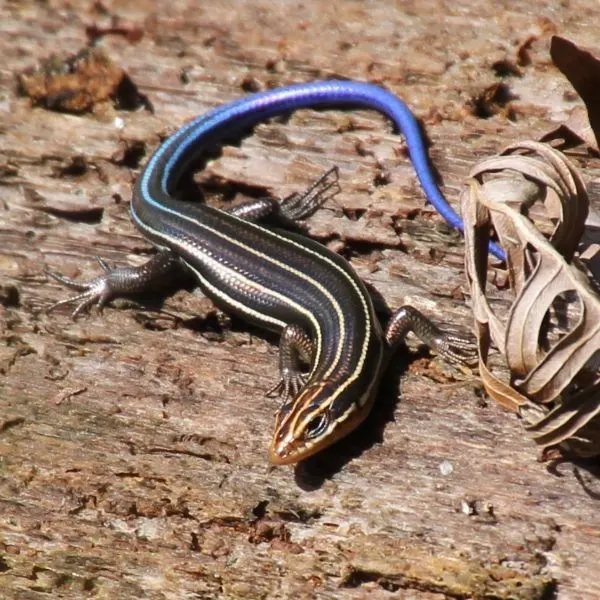
- Experience Level: Intermediate
- Family: Scincidae
- Scientific Name: Plestiodon inexpectatus
- Other Names: Five-lined Skink, Scorpion
- Adult Size: 5.5 to 8.5 inches
- Lifespan: 6 to 10 years
- Average Price Range: N/A
Southeastern five-lined skinks are the third type of five-lined skinks in Alabama. They are almost indistinguishable from common five-lined skinks. As a result, taxonomists spent over a hundred years believing they were the same species.
Juvenile southeastern five-lined skinks are black with five narrow dorsolateral lines and a bright blue tail. However, this pattern changes as they mature. Adults turn brown and lose their blue tail coloration.
Female adults are typically much darker than males. They also retain their five lines, while males only have traces of these lines. Older adult males may lose all stripe traces and develop uniform light brown skins.
You can tell southeastern five-lined skinks apart from other species by examining the scales under their tails. Unlike the other five-lined species, these skinks’ scales are of uniform sizes. Broadheads and common five-lined skinks have one uneven scale.
Southeastern five-lined skinks live in similar habitats to their common counterparts. However, southeastern five-lined skinks are better able to tolerate and even prefer arid places. So you can find them in places like dry pine forests.
These lizards climb, but they are equally comfortable on the ground. They often forage on the floor, climbing trees to hunt or bask in the sun when the ground temperature becomes suboptimal.
Mature males develop an orange wash on their jaws during reproductive seasons. Like all five-lined skinks in Alabama, they are highly territorial and aggressive towards other males. But they welcome females into their territories.
You can keep a southeastern five-lined skink in your home terrarium for display. Its care requirements are the same as common five-lined skinks.
This lizard is not picky about what it eats. Feed it with arthropods. However, it is good to vary its diet and occasionally toss in some fruits or worms.
6. Little Brown Skink
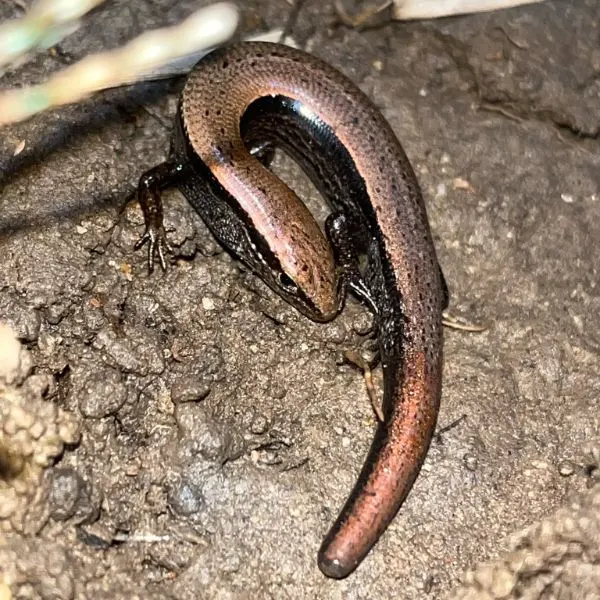
- Experience Level: Advanced
- Family: Scincidae
- Scientific Name: Scincella lateralis
- Other Names: Ground Skink
- Adult Size: 3 to 5.75 inches
- Lifespan: 2 to 4 years
- Average Price Range: N/A
Little brown skinks are called ground skinks because they spend all their time on the ground. While other skinks climb trees, ground skinks never do. Instead, they do all their hunting and basking on the floor.
You can find little brown skinks in moist forests abundant with leaf litter and floor debris. They enjoy traveling and foraging under the leaf litter and scarcely surface. As a result, you may have difficulty catching these skinks in the wild.
Little brown skinks are swift runners skilled at escaping predators. And that is because they have many! Their small sizes make them sumptuous targets for everything from snakes to bluebirds. Often, you only become aware of these skinks from the rustle of the leaves they have just left.
These lizards have transparent lower eyelids, an adaptation that makes it easy for them to see under debris. This feature also allows them to see with closed eyes. None of the other skinks in Alabama has this feature.
Another unique thing about these skinks is the lack of dramatic pattern change. The body pattern remains the same regardless of sex and stage of development.
You can identify this skink by its coppery brown skin and the broad dark stripe on each side of its body. This stripe runs from the snout to the tail. It is also common to find many ground skinks with dark brown to gold skins.
People rarely keep little brown skinks as pets due to their tiny bodies and short lifespans. Instead, many people who collect or breed them sell them in the pet trade as food for carnivorous reptiles.
Like other skinks in Alabama, little brown skinks consume high-insect diets. But you can also give them tiny fruit servings to vary their food intake.
Frequently Asked Questions
You probably have many questions about the skinks in Alabama after reading this article. Or maybe you need clarifications about specific issues.
This section contains clear answers to all your questions.
How do you identify skinks?
You can tell skinks apart from other lizards by their smooth scales, streamlined bodies, and short limbs. These limbs are functional in most skinks. Although some species are legless, none of the skinks in Alabama are. Skinks also lack distinct heads and have long tails.
How rare are skinks in Alabama?
Skinks are not rare in Alabama. However, this depends on the species. Five-lined skinks, for example, are common in most parts of the state. However, to varying degrees, other species like coal, southeastern, and northern mole skinks are rare. So you may have a hard time finding them even in their habitats.
What do skinks in Alabama eat?
The skinks in Alabama are predominantly insect eaters, but they eat other arthropods. Therefore, you can feed them roaches, spiders, beetles, and crustaceans. They also eat smaller invertebrates like worms.
It is fine to vary your skink’s diet by adding fruits like grapes or berries. However, do this in moderation. Too much of certain nutrients can harm this reptile.
Many adult skinks also eat small vertebrates occasionally. For example, broadheads often consume small lizards, including their immature young.
Are skinks in Alabama poisonous?
No. The skinks in Alabama are not poisonous. The belief that these lizards are poisonous is likely due to their snake-like appearance or the blue tail of several species’ young. Many wrongly assume that blue-tailed skinks are venomous and even refer to them as scorpions.
Skinks are safe to have around. While they may bite you if mishandled, the bite is harmless. All you will feel is a mild pain that quickly fades.
Where are skinks found in Alabama?
You can find skinks all over Alabama. Since some have wider distributions than others, check the geographical range of the species you are interested in before going herping.
You can find species like five-lined skinks, broadhead skinks, and ground skinks in almost any part of the state. Others have sparse populations restricted to certain parts of Alabama. For example, you are most likely to find coal skinks in the northwestern and southwestern areas.
Can you own a pet skink in Alabama?
Yes. You can own a pet skink in Alabama. However, protected species are off the table. These protected skinks include coal and southeastern five-lined skinks.
You need a license to collect, purchase, or sell these protected skinks. But given their threatened statuses, it may be challenging to get a permit to keep them as pets.
Wrapping up
Alabama is home to many different skink species. These skinks differ in behavior and appearance, which add to their diversity. Their unique traits also make identifying them in the wild easy.
Skinks are important members of the ecosystem. They consume large numbers of insects, helping to regulate insect populations and maintain ecological balance within their habitats.
If you plan to get a skink, avoid taking them out of the wild. Not only can it affect the ecosystem, but you also risk harming it. Skinks that cast their tails while trying to escape from you will spend energy they could use for other biological processes to regenerate it.
Ensure you get captive-bred skinks if you want a skink pet. Thankfully, skinks are beneficial whether you adopt officially adopt them or not. You can have fun watching them hunt in the wild.
Skinks in other states
